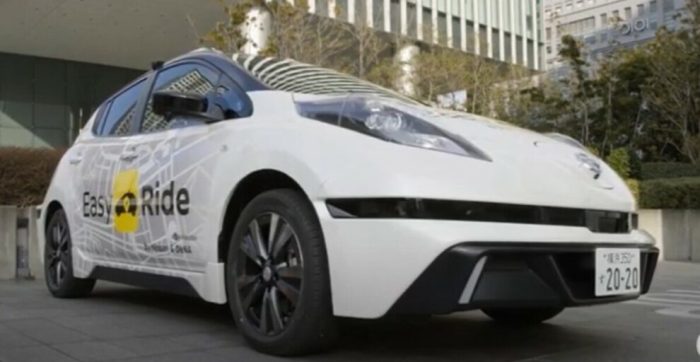Nissan’s Self-Driving Taxi Initiative in Japan
Nissan, a leading Japanese automaker, has been actively involved in the development and deployment of self-driving technology, with a particular focus on its application in the taxi industry. This initiative aims to revolutionize urban transportation in Japan by introducing autonomous vehicles that can navigate city streets safely and efficiently, offering a convenient and accessible alternative to traditional taxis.
Project Goals and Timeline
Nissan’s self-driving taxi initiative in Japan is driven by several key goals, including:
- Improving road safety: Self-driving taxis have the potential to significantly reduce accidents caused by human error, leading to safer roads for passengers and pedestrians alike.
- Enhancing accessibility: Autonomous vehicles can provide transportation services to individuals who may have difficulty driving themselves, such as the elderly or those with disabilities.
- Reducing traffic congestion: Self-driving taxis can operate more efficiently than human-driven vehicles, optimizing traffic flow and reducing congestion in urban areas.
- Promoting sustainability: Autonomous taxis can be integrated with smart city infrastructure to optimize energy consumption and reduce emissions.
Nissan has set an ambitious timeline for the deployment of its self-driving taxis in Japan. The company initially aimed to launch a pilot program in Yokohama in 2020, with plans to expand to other cities in the following years. However, due to various challenges, including regulatory hurdles and technological complexities, the timeline has been adjusted. Nevertheless, Nissan remains committed to bringing self-driving taxis to Japanese roads in the near future.
Technologies and Systems
Nissan’s self-driving taxis are equipped with a comprehensive suite of advanced technologies and systems, including:
- Sensors: These include lidar, radar, and cameras that provide a 360-degree view of the surrounding environment, enabling the vehicle to perceive obstacles and other vehicles.
- AI algorithms: Powerful artificial intelligence algorithms process sensor data in real-time, enabling the vehicle to make decisions, such as lane changes, acceleration, and braking.
- Communication protocols: Self-driving taxis communicate with each other and with traffic infrastructure through dedicated communication networks, allowing them to coordinate their movements and avoid collisions.
- High-definition maps: Accurate and detailed maps of the environment are essential for self-driving vehicles to navigate effectively. Nissan utilizes high-definition maps that provide precise information about road layouts, traffic signals, and other relevant features.
Challenges and Opportunities
The implementation of self-driving taxis in Japan faces a number of challenges, including:
- Infrastructure: Japan’s existing infrastructure, including roads, traffic signals, and communication networks, needs to be adapted to accommodate self-driving vehicles.
- Regulations: Current traffic laws and regulations need to be updated to address the unique characteristics of self-driving vehicles, such as liability in case of accidents.
- Public acceptance: The public needs to be convinced of the safety and reliability of self-driving taxis before they are widely adopted.
Despite these challenges, the introduction of self-driving taxis in Japan presents significant opportunities:
- Economic growth: The development and deployment of self-driving technology can create new jobs and stimulate economic growth in Japan.
- Improved quality of life: Self-driving taxis can enhance the quality of life for residents by providing convenient, safe, and accessible transportation options.
- Environmental benefits: Self-driving taxis can contribute to a more sustainable future by reducing traffic congestion and emissions.
The 2018 Pilot Program
Nissan’s journey into the world of autonomous vehicles took a significant step forward in 2018 with the launch of its pilot program for self-driving taxis. This program served as a crucial testing ground for Nissan’s technology and provided valuable insights into the practicalities and challenges of operating autonomous vehicles in a real-world setting.
Program Details
The pilot program was conducted in a controlled environment within the city of Yokohama, Japan. The program ran for a limited period, allowing Nissan to gather data and refine its technology in a controlled setting. The program focused on specific routes, allowing Nissan to evaluate the performance of its autonomous vehicles in a variety of real-world scenarios. These routes included both urban and suburban settings, exposing the vehicles to different traffic patterns, road conditions, and pedestrian activity.
Key Learnings and Outcomes
The 2018 pilot program yielded valuable insights into the capabilities and limitations of Nissan’s self-driving technology. The program highlighted the importance of robust sensor systems for accurate perception of the environment. The program also emphasized the need for advanced algorithms to handle complex traffic situations, such as merging, lane changes, and interactions with pedestrians.
The program’s success was evident in the vehicles’ ability to navigate various road conditions, including intersections, traffic lights, and pedestrian crossings. The program also demonstrated the effectiveness of Nissan’s autonomous driving system in handling unexpected events, such as sudden changes in traffic flow or unexpected obstacles.
Technical Challenges Encountered, Nissan test self driving taxis japan 2018
Despite the successes, the pilot program also encountered technical challenges that highlighted areas for further development. One significant challenge was the need to improve the vehicles’ ability to handle unpredictable situations, such as sudden changes in traffic flow or unexpected obstacles. Another challenge was the need to enhance the vehicles’ ability to adapt to different environmental conditions, such as varying weather patterns or road surface conditions.
The Role of Technology in Nissan’s Self-Driving Taxis
Nissan’s self-driving taxi initiative relies heavily on advanced technology to ensure safe and efficient autonomous driving. The company’s approach combines sophisticated hardware and software systems, utilizing a blend of advanced driver-assistance systems (ADAS), artificial intelligence (AI), and machine learning (ML). These technologies work in tandem to enable the vehicles to perceive their surroundings, make decisions, and navigate complex environments.
The Role of Advanced Driver-Assistance Systems (ADAS)
ADAS plays a crucial role in providing the foundation for Nissan’s self-driving taxis. These systems act as the vehicle’s “eyes and ears,” enabling it to perceive and respond to its surroundings. Here are some key ADAS features implemented in Nissan’s self-driving taxis:
- Adaptive Cruise Control (ACC): ACC uses sensors to maintain a safe distance from the vehicle ahead, automatically adjusting speed to maintain a preset following distance. This technology ensures smooth and safe driving, particularly in traffic.
- Lane Departure Warning (LDW): LDW monitors the vehicle’s position within its lane and alerts the driver if it detects unintentional lane drifting. This system helps prevent accidents caused by driver inattentiveness or fatigue.
- Automatic Emergency Braking (AEB): AEB uses sensors to detect potential collisions and automatically applies the brakes to mitigate or avoid an accident. This technology is particularly valuable in situations where the driver may not react quickly enough to avoid a collision.
- Blind Spot Monitoring (BSM): BSM uses sensors to detect vehicles in the driver’s blind spot, alerting the driver of potential hazards. This feature enhances safety by providing the driver with crucial information that might otherwise be missed.
These ADAS features provide a crucial foundation for autonomous driving by enabling the vehicle to perceive its surroundings and respond appropriately to potential hazards.
The Role of Artificial Intelligence (AI) and Machine Learning (ML)
AI and ML are essential for enabling Nissan’s self-driving taxis to make intelligent decisions and learn from experience. AI algorithms are used to process sensor data and make real-time decisions about vehicle control, such as steering, acceleration, and braking.
- Decision-Making: AI algorithms analyze sensor data to interpret the environment, identify potential hazards, and make informed decisions about vehicle control. This includes navigating intersections, merging into traffic, and adjusting speed based on traffic conditions.
- Route Planning: AI algorithms can optimize routes based on real-time traffic data, minimizing travel time and fuel consumption. This capability enhances the efficiency of the self-driving taxi service.
- Object Recognition: AI algorithms are used to identify and classify objects in the environment, such as other vehicles, pedestrians, and traffic signs. This enables the self-driving taxi to understand its surroundings and respond accordingly.
ML algorithms are used to continuously improve the performance of the self-driving taxi system. By analyzing vast amounts of data collected during real-world driving, ML algorithms learn from experience and refine the vehicle’s decision-making capabilities.
The Role of Data Collection and Analysis
Data collection and analysis are essential for refining and improving the performance of Nissan’s self-driving taxis. By gathering data from real-world driving scenarios, Nissan can identify areas for improvement and enhance the system’s capabilities.
- Performance Monitoring: Data collected during real-world driving is used to monitor the performance of the self-driving system, identifying areas for improvement and ensuring the system operates safely and efficiently.
- Scenario Analysis: Data analysis helps Nissan understand how the self-driving taxi performs in different driving scenarios, such as congested traffic, highway driving, and adverse weather conditions. This information allows for targeted improvements to enhance the system’s capabilities.
- Continuous Improvement: By analyzing data collected during real-world driving, Nissan can identify areas for improvement and refine the self-driving system’s algorithms. This continuous improvement process ensures that the self-driving taxi system remains safe, reliable, and efficient.
This ongoing process of data collection and analysis is crucial for ensuring that Nissan’s self-driving taxis are constantly learning and improving, providing a safe and reliable transportation solution for passengers.
The Future of Self-Driving Taxis in Japan: Nissan Test Self Driving Taxis Japan 2018
The introduction of self-driving taxis in Japan marks a significant shift in the transportation landscape. This technology has the potential to revolutionize how people move around cities, with implications for everything from traffic congestion to employment. As Nissan continues to lead the way in this exciting field, the future of self-driving taxis in Japan holds great promise.
The Potential Impact of Self-Driving Taxis on the Japanese Transportation Industry and Society
Self-driving taxis have the potential to significantly impact the Japanese transportation industry and society. This technology could improve safety, reduce traffic congestion, and enhance accessibility for people with disabilities.
- Increased Safety: Self-driving vehicles are designed to be more cautious and aware of their surroundings than human drivers, potentially leading to a reduction in accidents. According to a study by the National Highway Traffic Safety Administration (NHTSA), 94% of traffic accidents are caused by human error. Self-driving vehicles, with their advanced sensors and algorithms, could significantly reduce this human error factor, resulting in safer roads.
- Reduced Traffic Congestion: Self-driving taxis can operate more efficiently than human-driven vehicles, potentially reducing traffic congestion. By optimizing routes and eliminating the need for parking, self-driving taxis can make better use of existing infrastructure, reducing the time people spend stuck in traffic. For example, a study by the University of California, Berkeley, found that self-driving vehicles could reduce traffic congestion by up to 30% in major cities.
- Enhanced Accessibility: Self-driving taxis can provide greater accessibility for people with disabilities, seniors, and those who cannot drive. This could improve their quality of life by giving them greater independence and access to services and opportunities.
Nissan test self driving taxis japan 2018 – Nissan’s 2018 pilot program in Japan serves as a testament to the company’s commitment to developing innovative and sustainable transportation solutions. While challenges remain, the program’s success has paved the way for future advancements in self-driving technology, with the potential to transform the way we move around our cities.
Imagine cruising through Tokyo in a self-driving Nissan taxi, a futuristic vision that was being tested back in 2018. While that tech is still evolving, the world was buzzing with a different kind of anticipation back then – the release of the Batman v Superman: Dawn of Justice trailer. The clash of titans on the big screen was a spectacle that captured everyone’s imagination, just like the potential of self-driving cars to revolutionize transportation.
It’s fascinating to think about how both those technologies, in their own ways, were shaping the future we live in today.
 Standi Techno News
Standi Techno News

